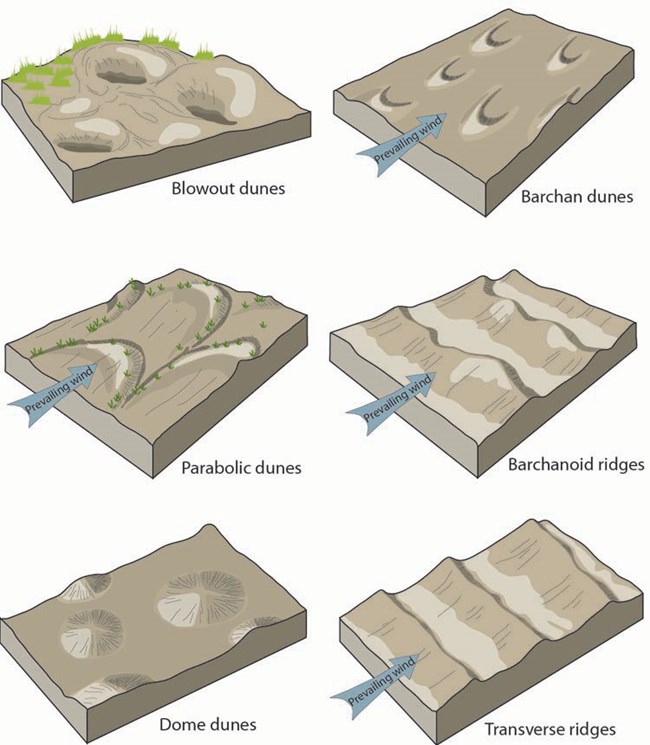
NPS Photo/Patrick Myers
Introduction
Aeolian landforms are shaped by the wind (named for the Greek God of wind, Aeolus). Aeolian processes create a number of distinct features, through both erosion and deposition of sediment, including:
- Sand dunes
- Loess Deposits
- Ventifact
- Yardangs
- Deflation Hollow or Blowout
- Desert Pavement
Aeolian processes involve erosion, transportation, and deposition of sediment by the wind. These processes occur in a variety of environments, including the coastal zone, cold and hot deserts, and agricultural fields. Common features of these environments are a sparse or nonexistent vegetation cover, a supply of fine sediment (clay, silt, and sand), and strong winds. Aeolian processes are responsible for the emission and/or mobilization of dust and the formation of areas of sand dunes. They largely depend on other geologic agents, such as rivers, glaciers, and waves, to supply sediment for transport.

Trista L. Thornberry-Ehrlich, Colorado State University after Fryberger, S.G., L.F. Krystinik, and C.J. Schenk. 1990; and McKee, E.D. 1966.
Sand Dune Landforms
Sand dunes (both active and stabilized by vegetation) can be found along beaches, and in arid or semi-arid regions.
Dunes are mounds of loose sand created by wind and are the most well known aeolian features. There are a varitety of types of dunes, depending on their shape. Most dunes share a common profile, or cross section, with a long shallow angle (stoss) facing into the wind, a peak (crest), and a steep lee side.
Dunes seldom exist by themselves, but as vast fields of many dunes.
Coastal Dunes
Coastal dunes are critical to the health and sustainability of sandy beaches. The primary dune ridge (foredunes) lies adjacent to the shoreline. Secondary dune fields may lie further inland. Dunes may form anywhere that eolian processes (wind transportation) occur. Dunes provide much-needed protection to back-barrier environments (including human development) against severe wave, wind, and storm events. In addition, these geomorphic features provide critical habitat to a variety of migratory birds and mammals. Dune vegetation is very important for the formation and stabilization of dune complexes on barrier islands. Both the root system and exposed vegetation restrict sand movement around plants, helping to secure the dune.

Other Aeolian Landforms
Other types of aeolian features include:
Deposition Features
- Loess - wind-blown silt deposits common along the Mississippi River Valley
Erosional Features
- Ventifacts are geomorphic features made of rocks that are abraded, pitted, etched, grooved, or polished by wind-driven sand or ice crystals. They are most typically found in arid environments with little vegetation to interfere with these erosive processes. If ancient ventifacts can be preserved without being moved or disturbed, they are excellent paleo-wind indicators as the grooves and striations cut into the rock are parallel with the wind direction.
- Yardangs - streamlined ridges of compact sand lying in the direction of the prevailing wind, formed by wind erosion of surrounding material
- Deflation Hollows - also called a blowout dune, created when loose surface material is scooped out by the wind, leaving a hollow.
Photo Galleries
Geological Monitoring
Aeolian Landforms in Parks
- Assateague Island National Seashore, Maryland, Virginia—[Geodiversity Atlas] [Park Home]
- Cape Cod National Seashore, Massachusetts—[Geodiversity Atlas] [Park Home]
- Capitol Reef National Park, Utah—[Geodiversity Atlas] [Park Home]
- Castle Mountains National Monument, California—[Geodiversity Atlas] [Park Home]
- Channel Islands National Park, California—[Geodiversity Atlas] [Park Home]
- Death Valley National Park, California and Nevada—[Geodiversity Atlas] [Park Home]
- Fire Island National Seashore, New York—[Geodiversity Atlas] [Park Home]
- Fort Matanzas National Monument, Florida—[Geodiversity Atlas] [Park Home]
- Golden Gate National Recreation Area, California—[Geodiversity Atlas] [Park Home]
- Great Sand Dunes National Monument, Colorado—[Geodiversity Atlas] [Park Home]
- Guadalupe Mountains National Park, Texas—[Geodiversity Atlas] [Park Home]
- Indiana Dunes National Lakeshore, Indiana—[Geodiversity Atlas] [Park Home]
- Joshua Tree National Park, California—[Geodiversity Atlas] [Park Home]
- Kobuk Valley National Park, Alaska—[Geodiversity Atlas] [Park Home]
- Mississippi National River and Recreation Area, Minnesota—[Geodiversity Atlas] [Park Home]
- Mojave National Preserve, California—[Geodiversity Atlas] [Park Home]
- Padre Island National Seashore, Texas—[Geodiversity Atlas] [Park Home]
- Pictured Rocks National Lakeshore, Michigan—[Geodiversity Atlas] [Park Home]
- Presidio of San Franscisco, California—[Geodiversity Atlas] [Park Home]
- Sleeping Bear Dunes National Lakeshore, Michigan—[Geodiversity Atlas] [Park Home]
- White Sands National Monument, New Mexico—[Geodiversity Atlas] [Park Home]
- Timucuan Ecological and Historic Preserve, Florida—[Geodiversity Atlas] [Park Home]
- Wright Brothers National Memorial, North Carolina—[Geodiversity Atlas] [Park Home]
Last updated: December 1, 2022
